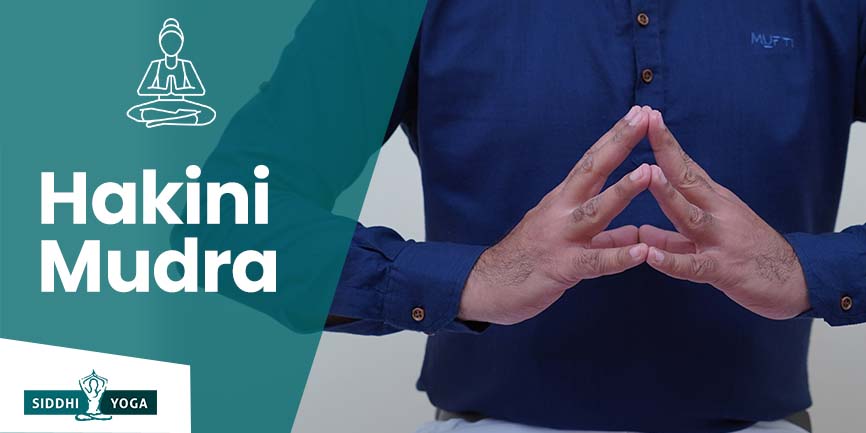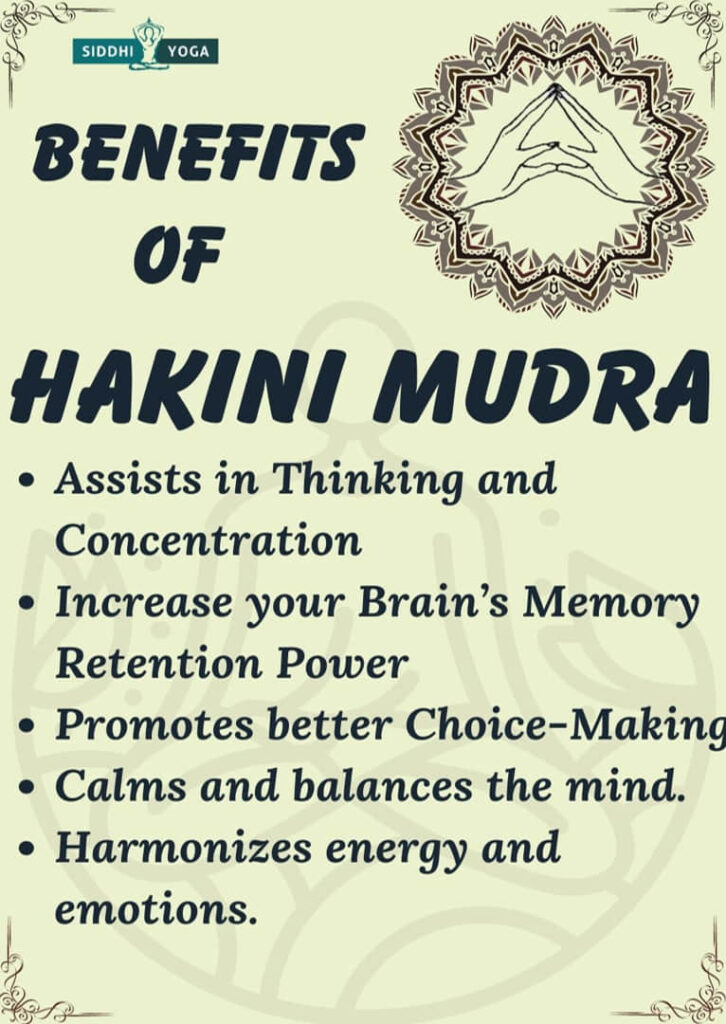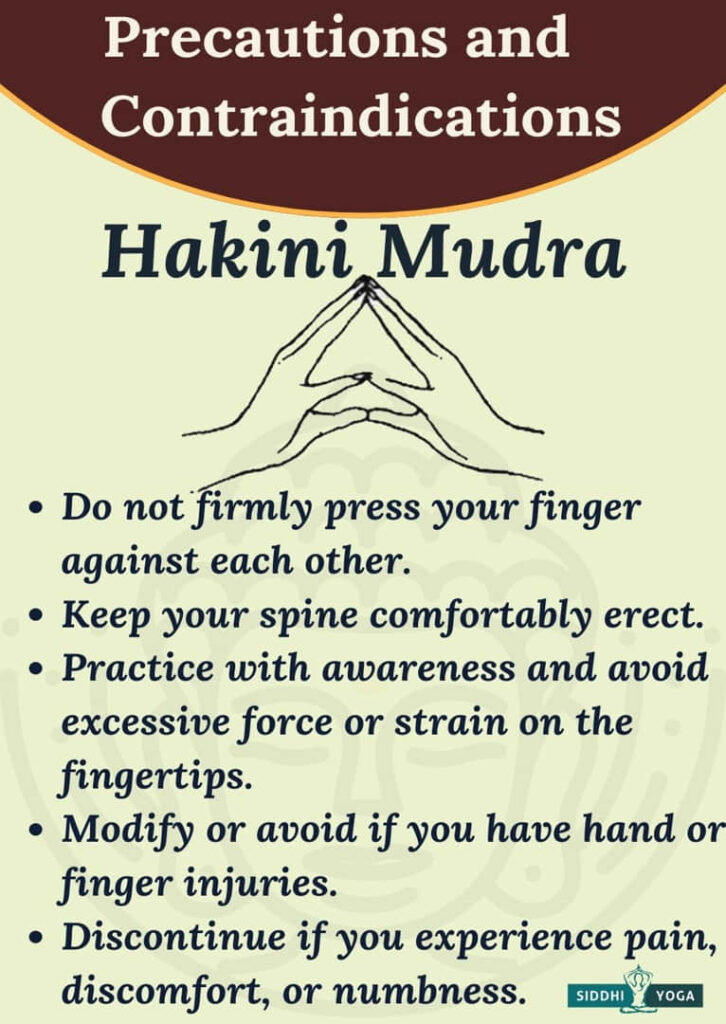
Hakini mudra is a simple yoga mudra. Find out what Hakini Mudra is and how to do it for benefits like improved mental clarity and reduced stress.
Definition – What is Hakini Mudra and its Meaning, References, and Mythology?
Hakini Mudra is one of the widely used hand gestures/ seals. This Mudra was named after the Hindu goddess Hakini. It is believed that it helps to open the third eye chakra.
Hakini Mudra is also known as “Power gesture” or “Gesture of Power.” Most of the trained speakers use this Mudra when they are talking. This makes you feel more confident and more truthful. So, if you are in a place where you need to deliver some instructions or provide a speech or something, then it is an ideal gesture to start with. Many yoga trainers use this Mudra as well. It helps in better and more effective communication. Many famous personalities and leaders use this Mudra, and now you know why.
Goddess Hakini is believed to be as Goddess of Power. That is where the English translation “Power Gesture” came from. However, such is not entirely true. Many people only consider physical ability as their power. In recent years this world has witnessed “Soft Power” as well. For starters, soft power depends on your ability to manipulate certain aspects just by speaking about it. So that’s why Hakini Mudra has been so relevant in recent days.
Hakini Mudra not only does that but also boosts the speaker’s confidence. After practicing this, you can lose the awareness of nervousness. It is not that nervousness is bad, but at places where nervousness is not required, you can practice this.
Hakini Mudra also helps establish a better connection between the brain’s two hemispheres. It is one of the Mudras which improves your brain’s ability to make you more productive.
It is related to the awakening of the Third eye chakra, which denotes power, so it makes you more powerful. You will feel more powerful and energized after practicing this Mudra. The third eye chakra is also closely related to the brain; hence it promotes better cognitive functioning of the brain.
So, one must practice this whenever some kind of nervousness surrounds them.
You may also like: Online Yoga Teacher Training
Alternate Names of Hakini Mudra
Power gesture or Gesture of Power, Brain Power Mudra.
How to do Hakini Mudra?
- You can practice this while performing any Asana if you are comfortable doing so.
- To perform this, start by sitting in a comfortable meditative posture (Sukhasana or Padmasana). Whichever posture you find comfortable while sitting is fine.
- Keep your neck and spine comfortably erect.
- Rest both of your palms comfortably on your knees.
- Gently close your eyes.
- Observe this dark space behind your eyes.
- Witness your mind.
- Breathe deeper and longer. With every passing breath, make your breathing even deeper.
- Now, slowly and gently bring both of your hands close to the Heart Chakra (Close to the sternum) and gently join all the fingertips together. Keep your fingers comfortably spread away from each other.
- Witness the power.
- Witness your entire mind and body.
Hakini Mudra Benefits

- It assists in thinking and concentration.
- It is a great value for those with too much mental work.
- Practicing this can increase your brain’s memory retention power.
- You will get more productive at your work as both of your brain’s hemispheres function more effectively.
- If you have forgotten something you want to remember, you can practice it, which might help you remember quickly.
- It promotes better choice-making by clearing thoughts.
- It helps to grasp things quickly.
Hakini Mudra Precautions and Contraindications

Similar to all other Mudra practices, it has no side effects.
However, there are a few things to consider:
- Do not firmly press your finger against each other. They should be slightly touching each other and do not put excessive pressure. However, if you experience nervousness, you might do that at a time like that; you just must remember to be gentle with yourself.
- Keep your spine comfortably erect.
When and how long to do Hakini Mudra?
- One must practice this whenever nervousness surrounds them, which will help boost your confidence.
- You can practice this while walking, talking, sitting, or lying. There’s no limitation to that.
- If you have some work where you are going to speak in public.
Morning is the ideal time to do any yoga or Mudra. Our brain is at its best in the morning and during the daytime. So, you are more likely to be able to concentrate easily. Therefore, you should practice this Mudra from 4 am and 6 am to get the most effective outcomes.
If you are having difficulty with this during the morning, you can do this Mudra later in the evening too.
Based on research, the best way to practice an exercise for at least 20 minutes is to get the best benefits of that Mudra. Practicing this Mudra for a minimum of 30-40 minutes daily is recommended. Whether you wish to complete it in one stretch or two threes that last between 10 and 15 minutes, it’s up to you.
Breathing in Hakini Mudra
There are three types of breathing we can practice with this Mudra:
- Abdominal Breathing
- Thoracic Breathing
- Yogic Breathing (Abdominal Breathing, Thoracic Breathing & Clavicle breathing.)
Visualization in Hakini Mudra
- Visualize that your thoughts are getting settled.
- Whenever you speak, the right choice of words themselves starts to formulate.
Affirmation in Hakini Mudra
While practicing this, Keep a positive intention. Start with:
“I am the epitome of confidence. I am filled with confidence.”
Conclusion
Hakini Mudra is a hand gesture that balances the left and right hemispheres of the brain. The Hakini Mudra has many benefits, including reducing stress, improving memory, and increasing concentration. If you want to learn more about mudras and how to use them in your life, consider taking our Mudras Certification Course. In this course, you’ll learn about 108 different mudras and how to use them for maximum benefit. Sign up today to get started on your journey to improved health and well-being!